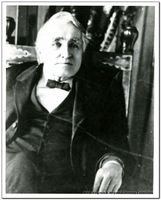 | Back to e-WV
| Back to e-WV
 The West Virginia Encyclopedia
The West Virginia Encyclopedia
 | Back to e-WV
| Back to e-WV
 The West Virginia Encyclopedia
The West Virginia Encyclopedia

Industrialist James Otis Watson (May 17, 1815-June 12, 1902) was born at Benton’s Ferry near Fairmont. The eldest son of Thomas and Rebecca Haymond Watson, James received instruction at home. He then operated a store, engaged in the cattle trade, started a brick works, and organized the construction of the Fairmont-Palatine suspension bridge. In 1852, he joined with future governor Francis H. Pierpont to open a mine in Fairmont, which exported the first coal from Western Virginia on the Baltimore & Ohio Railroad. In 1861, Watson served as a delegate to the Second Wheeling Convention, a key event in the founding of West Virginia.
After dissolving the Pierpont partnership in 1874, Watson joined his son-in-law, future governor Aretas B. Fleming, to open the Gaston mine near Fairmont. In 1886, the partners started the Montana mine, a great success which led to the opening of additional mines along the West Fork River. In 1901, the Watson mines were combined in a single corporation, the Fairmont Coal Company, the predecessor of industry giant Consolidation Coal.
A Democrat and Episcopalian, Watson built a mansion in Fairmont, La Grange, where he resided until his death. He married Matilda Lamb in 1841, and the couple had ten children. Three of his sons, James Edwin, Clarence Wayland, and Sylvanus Lamb, became prominent in the coal industry.
Son James Edwin Watson (January 8, 1859-August 2, 1926) was born at Fairmont. He learned the coal business at his father’s Gaston mine, and managed the Watson coal interests until 1899. He also organized the Bank of Fairmont, and was a director of the Fairmont & Clarksburg Traction Company, the Fairmont Development Company, the Consolidation Coal Company, and other concerns. In 1909, James E. Watson built a large Tudor Revival mansion, High Gate, in Fairmont, where he resided until his death.
Written by Michael Edward Workman
Caudill, Harry M. Theirs be the Power: The Moguls of Eastern Kentucky. Chicago: University of Illinois Press, 1983.
Watson, James O. The Valley Coal Story. Fairmont Printing Co., 1957.
The Fairmont Field. Northern West Virginia Coal Fields: Historical Context. Morgantown: Institute for the History of Technology & Industrial Archaeology, 1994.